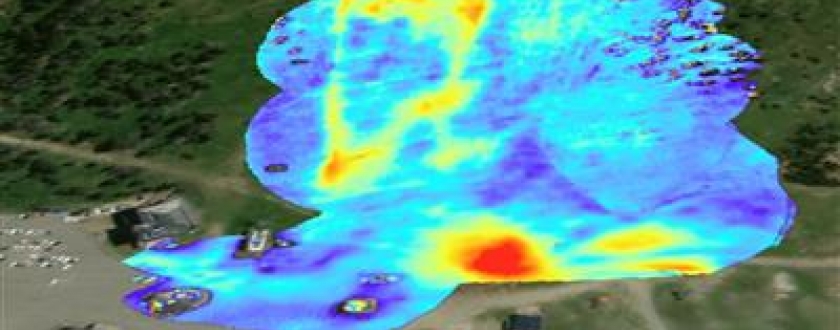Optimising snow tourism resource use
Description of the case study
This study case seeks to optimise the use of resources at ski resorts through better snow management and planning. The proposed strategy is focused on establishing continuous monitoring of snow cover thickness through a combination of different techniques. The techniques implemented are the installation of GNSS (Global Navigation Satellite Systems) and RTK (Real-Time Kinematic) receptors in snow groomer machines to measure the absolute height of snow on the surface, and the integration of LiDAR technology on unmanned aerial vehicles (drones) to scan the ground. Both techniques calculate the snowpack’s thickness using the differential between the snow-free digital model of the terrain taken with high precision.
Two pilot tests were carried out in Andorra with the aim of evaluating the technical, economic, and operational viability of both systems: once in Grandvalira during the 2019-2020 season, and the other in Vallnord during the 2020-2021 season.
• Reducing snow tourism energy and water resource usage through improvements in snow management and planning.
• Mitigating the adverse effects of climate change in terms of the number of skiable days through the optimisation of artificial snow production and ski slope packing.
• Finding viable solutions on a technical and economic level to minimise the impacts of intensified artificial snow production due in part to climate change. Among these impacts, of particular note are the additional economic expense this represents for ski resorts due to increased energy consumption, as well as the increased pressure on water resources.
» Proving the GNSS-RTK technology installed on snow groomer machines to measure the absolute height of snow on the surface.
» Proving that there is sufficient signal reception (GNSS) in mountain areas to obtain precise centimetric measurements.
» Designing and integrating data measurement, recording, and communication devices into snow groomer machines.
» Designing an algorithm to correct the snow groomer machine dynamic to obtain the absolute height of snow on the surface.
» Visualising the system’s estimated snow thickness in real time, as well as other variables of interest (for example, daily evolution, metrics by slope, sector, etc.).
» Evaluating the technical, economic, and operational viability of integrating LiDAR technology into an unmanned areal vehicle (drone) with the aim of measuring snow cover thickness.
The validations carried out during the pilot tests demonstrated that it is possible to measure the absolute height of snow with centimetric precision (error < 2 cm) using GNSS-RTK technology installed on snow groomer machines.
The project has allowed data measurement, recording, and communication devices to be designed and integrated into snow groomer machines at a low cost, as well as implementing an algorithm to correct machine dynamics and obtain the absolute height of snow on the surface. Measurements taken in Grandvalira during the 2019-2020 season.
In addition, the LiDAR technology integrated into drones was shown to be a complementary system to the use of snow groomer machines when estimating snow cover thickness. Despite the distance covered by the vehicle being more limited, this technique allows specific scans to be made with greater detail in areas of particular interest.
Case study developed, implemented, and partly funded as a climate change adaptation measure.
OBSA (http://www.obsa.ad/), Actua Innovació (https://www.actua.ad/en/innovationhubandorra), EPS (http://www.eps-works.com/), and CENMA-IEA (https://www.iea.ad/cenma)
Additional Information
Ski resort managers are the stakeholders with whom work was carried out most intensely. In particular, SAETDE (manager of the Grau-Roig and Pas de la Casa sectors within Grandvalira) and EMAP (manager of Pal-Arinsal within Vallnord). Both entities were involved in the project during its three major phases: design, execution, and evaluation. In terms of the assistance received, of particular note is the support outfitting the snow groomer machines, communicating snow cover actions, and executing validations and returns on the services provided. This continuous communication with technicians as well as managers of artificial snow production and machine operations was key to understanding the resorts’ needs and improving the service.
Despite having already carried out two pilot tests, the project is still collecting success and failure factors for the systematisation of best practices, which will be carried out at a later stage. In any case, it should be noted that it is necessary to carry out a feasibility study according to the resort prior to implementing these techniques since there will still be resorts where the activity is not viable in the coming decades, even with these investments.
At this phase of the project, no cost/benefit assessment has been carried out on the actions executed.
The tourism sector is the economic driver of the Pyrenees region and, in turn, one of the most demanding sectors in terms of energy and water resource usage. Snow tourism has been identified as extremely vulnerable to the effects of climate change. As the only country located entirely in the Pyrenees, Andorra is highly aware of these facts. Law 21/2018 on driving the energy transition and on climate change lays out a road map for mitigating and adapting to climate change in Andorra. Innovation and research are identified as essential pillars of this transition.
This project received financing from the POCTEFA (PIRAGUA_EFA210/16 Project) programme. EPS-Works has partially financed its actions thanks to the Government of Andorra’s support for Andorra-focused projects.
09/01/2019 - 12/31/2021 (2 years - in progress)
Reference information
PYRENEAN CLIMATE CHANGE OBSERVATORY
Avenida Nuestra Señora de la Victoria, 8
22.700 - Jaca
Huesca - España
+34 974 36 31 00
info_opcc@ctp.org





